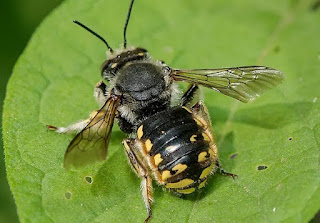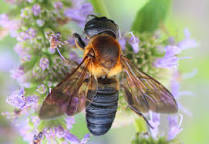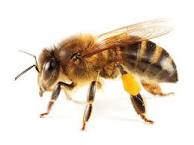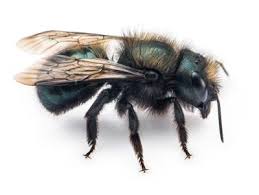Types of Bees Long Island New York
There are more than four hundred species of bees found in the state of New York. The majority of bees on Long Island, New York, are ground-nesting digger bees. While most bees on Long Island are ground-nesting, an example of which is bumblebees, several bees construct nests in above-ground structures. Above ground cavity nesters in New York include honey bees, wool carder bees, mason bees, carpenter bees, and resin bees.
Honey Bees - The Honeybee is indigenous to Southeast Asia and was spread to four continents by humans. The honeybee is a social flying stinging insect, which lives in colonies and has three castes: queens, workers, and drones. In a honey bee colony, a fertilized egg can develop into a queen or a worker, dependent upon the diet provided to the developing bee larvae. Bee larvae destined to become queens are fed royal jelly, and larvae destined to become workers are fed bee bread. Drones develop from unfertilized eggs. Honeybees nest in cavities that are approximately forty liters in volume and ten or more feet above the ground. The honey bee provides highly valued pollination services for various crops and ranks as the most frequent single species of pollinator for crops worldwide. Honey bee workers and queens are female, while drones are males. Worker honey bees are the most commonly seen member of the honeybee hive, as they make up about 99% of each colony's population. The worker bees do just about everything for the hive. From birth to her death forty-five days later, the worker honey bee is given various tasks during different life stages. Worker bees are responsible for everything, from feeding the bee larvae to tending to the queen, cleaning the beehive, collecting pollen, guarding the bee colony, and building the honeycomb. The worker bees sting hive intruders as a form of defense, and alarmed honey bees release a pheromone that triggers the attack response in other worker honeybees. The drones' purpose is to mate with queens from other beehives. If the drones do get the opportunity to mate with a queen, they die immediately afterward. If the drones do not mate, they can survive for ninety days. Drones can be identified in the beehive by their large round bodies and big eyes. Drones do not have a stinging capacity.
There is one queen honey bee per hive, and she is the mother of all the other bees. The queen bee has a life expectancy of approximately five years and is the only fertile member of the colony, and lays about 1,500 eggs a day during the spring and summer months. Egg-laying begins in early spring, initiated when the workers bring the first fresh pollen home. Egg production will continue until fall, or as long as pollen is available. Queen honeybees are distinguished from the other hive members by their smooth, elongated abdomens and small wings. Shortly following birth, queen honey bees will leave the colony and mate with fifteen or more drones for three days before returning to the hive to lay eggs. The queen will not leave the hive again unless the bee colony swarms in search of a new home.
 |
| Bumble Bee |
Bumblebees - These bees have large black and yellow hairy round bodies. This stinging flying insect is found in the northeastern United States. There are forty-six species of bumblebees in North America, and they are the only bees native to North America that are truly social. The collecting of pollen and nectar from flowers by bumblebees is common in Long Island, New York, but they can become a nuisance when nesting near Long Island homes. Bumblebees typically nest under piles of wood, dead leaves, compost piles, underground in vacant rodent burrows, or even inside walls of Long Island residences or buildings. Bumblebees are generally not aggressive but will defend themselves or their nest with repeated stings when threatened. Skunks may dig up bumblebee ground nests to feed on the bee brood. Adult bumblebees are preyed upon by bee wolves and robber flies. The stinging ability of bumblebees renders them pests to many. However, like honeybees, bumblebees are also essential pollinators that contribute to agricultural food production. The main crop pollinated by bumblebees is the tomato. Bumblebees are vital to the pollination of green pepper, strawberries, eggplant, and cantaloupe in greenhouses and, to a lesser extent, cherries, almonds, and plums on open farms. Bumblebees are capable of flight in colder temperatures and lower light levels than many other bees.
A colony of bumblebees is comprised of three types of individuals (a queen, sexually undeveloped female workers, and males, called drones). Bumblebee nests are constructed during the spring by solitary, overwintered, fertilized queens. After selecting a site, the queen bee builds a nest and lays six to eight eggs that hatch into worker bees in four to five days. The queen bee will raise the first brood of worker bees on pollen and nectar collected from flowers. It takes about twenty-one days to develop into an adult bumblebee. Following the first brood's rearing, the worker bumblebees will provide food and nourishment to the bee larvae and defend the colony while the queen bumblebee shifts her efforts to the production of eggs. Over the summer, the nest may give rise to fifty to four hundred worker bumblebees. Worker bumblebees have a life expectancy of four to six weeks. The bumblebee colony produces new queen bees and drones in late summer, which will leave the nest to mate. The successfully mated queen bumblebees will hibernate two to five inches deep in the ground soil. Drones and worker bees die off at the end of the season, while dormant fertilized queen bees survive to repeat the cycle the following year.
 |
| Carpenter Bee |
Carpenter Bees - These wood-boring insects are also known as wood bees and are the largest bees native to the United States. Carpenter bees resemble bumblebees but generally have a hairless, shiny abdomen. Unlike honeybees and bumblebees, carpenter bees are not social insects and don't live in colonies. Carpenter bees are essential pollinators of flowers and like to tunnel and nest in wood. Using their strong jaws, they excavate precisely rounded galleries in wood to raise their young. In the tunnel, a female carpenter bee will excavate five or six cells for the housing of eggs. Carpenter bees produce piles of sawdust as they create perfectly round holes in wood, which are approximately 1/2" in diameter. Carpenter bee nesting sites at Nassau County Long Island residences commonly include eaves, rafters, fence posts, fascia boards, siding, wooden shake roofs, decks, and outdoor wooden furniture. Carpenter bees will take up residence in weathered wood, typically softer varieties such as cedar, pine, redwood, and cypress. A great deal of damage can result when the same wood pieces are infested with carpenter bees year after year. Woodpeckers are natural predators of carpenter bees and will drill holes into the tunnels, creating more extensive damage to feed on the carpenter bee larvae.
Carpenter bees have a lifespan of three years and have four life stages: egg, larval, pupal, and adult. It takes about seven weeks for a carpenter bee to reach adulthood, but maturation time may vary depending on the temperature and other environmental factors. Newly developed carpenter bee adults usually remain in their wood galleries for several weeks and exit their brood cells in April or May. The carpenter bees mate and will feed on pollen and nectar. The carpenter bees will return to their wood gallery nests in the fall, where they will hibernate and emerge the following spring. Female carpenter bees give rise to one generation of offspring on Long Island, but they may have two or more generations per year in southern states.
Mason Bees - These small bees are essential pollinators of crops, wildflowers, and many other woodlands, meadow, and wetland plants. Unlike honeybees, which are social insects, mason bees are tunnel-nesting solitary bees. Every female mason bee is a queen who lays eggs and raises its offspring independently. Mason bees do not excavate their nests. Mason bees construct individual nests in hollow reeds or other plant stems, pre-existing cavities, or tunnels found in wood created by wood-boring beetles or carpenter bees. The mason bee's name originates from its habit of transporting mud to nesting areas to construct structures where they will lay eggs.
 |
| Wool Carder Bee |
Wool Carder Bees - This bee is native to Europe, Asia, and North Africa. The wool carder bee was accidentally introduced into North America from Europe sometime during the mid 20th century and was first seen in 1963 near Ithaca, New York. The wool carder bee is often mistaken for a yellow-jacket wasp since both display bright yellow markings on their abdomen. However, wool carder bees are hairier and more robust in shape than yellow jackets. The European wool carder bee is a solitary, cavity-nesting bee species. Females wool carder bees use pre-existing cavities for brood cell construction. Potential nesting sites include holes in wood, such as those excavated by wood-boring beetles or other insects, hollow plant stems and reeds, and cracks and crevices in walls. Wool carder bees are so named because the female bees scrape and collect the soft downy hairs of fuzzy plants to build nests for their young. Female wool carder bees collect wooly materials using their mandibles to scrape fuzzy trichomes from pubescent leaves, especially lamb's ear. While most bees carry pollen on their hind legs, this family is unique because they transport pollen on their abdomen.
 |
| Giant Resin Bee |

